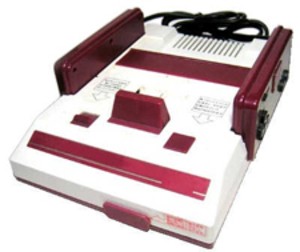
Many things were fads to be forgotten forever, others live on as icons of the generation. The Nintendo Entertainment System (or NES to its friends) is one such iconic figure, living on in the hearts and minds of gamers everywhere and securing its place in popular culture forever.
The legacy of the NES started back in 1983 when Nintendo released the Famicom games console in its native Japan, sporting a bright red-and-white colour scheme and two hardwired controllers. With the popularity of launch titles such as Donkey Kong and Popeye it went on to be a success - so much so that Nintendo's eyes were trained at the potentially lucrative North American market. This was a brave move; the video game crash of 1983 had left many companies in the gaming industry bankrupt. The market collapsed, flooded with poor quality games (the notoriously bad E.T. and Pac-Man games on the Atari 2600 being cases in point), destroying the goodwill of consumers who reacted by exercising their purchasing power, or rather, not. The blame was laid squarely at the door of companies like Atari, and videogames were a no-go zone.

In light of this it probably wasn't the smartest move for Nintendo to strike up a deal with Atari to manage the American debut of the Famicom. Whilst the Atari brand was still undeniably strong, consumers were losing confidence and Atari were haemorrhaging money like profit had gone out of fashion. Upon seeing an unlawful clone of Donkey Kong on a rival Coleco system, the deal soured and Atari pulled out. Ironically, this was the best thing that could have happened to Nintendo, who responded both decisively and ingeniously to what was a major setback.
Seemingly undeterred by going it alone, Nintendo rebranded the Famicom as the Nintendo Entertainment System. The quirky looks were replaced with an uninspiring grey box with a front-loading slot for game cartridges, presumably to make it look less like a toy and more like a VCR in order to win acceptance with a disillusioned consumer base. Not wishing to follow in Atari's footsteps and lose favour with the public due to lousy third-party software, Nintendo took the bold step of introducing the 'Nintendo Seal of Quality' standard. Companies wishing to publish a game on Nintendo's console must have it approved by Nintendo to ensure it was of a sufficient standard. Not only this, but they were bound to exclusivity deals precluding them from developing for rivals' systems.
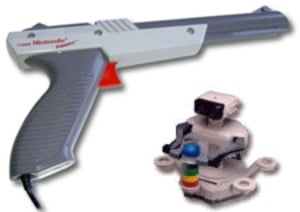
There were a few more tricks up Nintendo's sleeve. Following the video game crash retailers were still cautious about videogame related products, a problem Nintendo circumvented by agreeing to buy back all unsold inventory. To further distinguish itself from other gaming machines of the day, the NES was released with R.O.B. and the Zapper light gun, ostensibly to convince toy stores that this was, in fact, a toy and not a console. It was a strategy that paid off as this helped get the NES in the shops and recognised, despite the company actually posting an initial loss. Nevertheless, the basis had been created with retailers as to the commercial viability of the NES.
R.O.B. was a robot accessory that proved to be a novelty with limited appeal. It was bundled with the NES deluxe pack and helped lure retailers and consumers when it was most important. The Zapper, a light gun, was received with much more enthusiasm because it was actually fun! Duck Hunt and Hogan's Alley were instantly appealing as you could just point the gun at the TV screen and blast away. For the second batch of consoles, Nintendo revised the hardware slightly to make it cheaper to manufacture, and re-entered the market at full force.
The NES controller was such an innovation that virtually every videogame controller designed after the NES owes something to its design. Along with a very compact design which fitted snugly in a gamers hands there were four buttons and a four way directional D-Pad, which was designed to be a superior alternative to the clunky joysticks used by Atari previously. There was no going back once gamers got used to this arrangement.
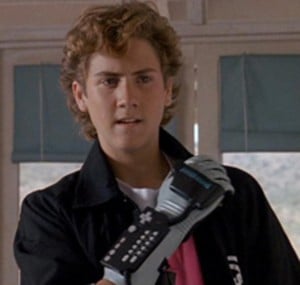
By the late 80s Nintendo's supreme confidence in its product, combined with its not-inconsiderable business acumen had the gaming industry sewn up. It is estimated that one in three American homes owned an NES and Nintendo characters could be found on cereal boxes, Saturday morning cartoon shows and all manner of merchandising. Perhaps the most blatant marketing manoeuvre was to be found in the film 'The Wizard', featuring the kid everyone liked from the Wonder Years TV show. Cunningly released about 2 months before the release of Super Mario Bros. 3 in the USA it shows how good Nintendo had become at marketing by this point. Even the woeful Power Glove peripheral got pimped.
So, with Japan and North America wrapped up you might assume that Europe was an easy nut to crack. Not so; Sega, Nintendo's arch nemesis from Japan, had struck a deal with Virgin Mastertronic to distribute the Sega Master System in the UK and other parts of Europe. It's hard to get exact European sales figures for the era but the perception is that at least for the early days from 1986 to 1990 Sega's 8-bit bag of tricks had the upper hand over the NES in Europe. Sega didn't enjoy much success with the Master System in America, having seconded the distribution rights to Tonka who made a real mess of it, securing only about 5% market share. In Europe the NES was distributed by Mattel and initially received a less than enthusiastic response.
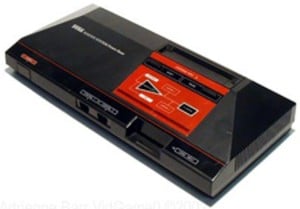
Like many Brits, I was given a Sega Master System for Christmas one year. With classics like Wonderboy, R-Type, California Games, Phantasy Star, Alex Kidd, Psycho Fox and Shinobi, it is easy to see why it was such a huge success. In fact, all my friends at school were Sega fans so I rarely even came across the NES as a young teenager. That's not to say that the lure of the NES wasn't strong at the time; my local department store had an NES set-up with several of the best games at the time set up to play on a 3 minute timer.
Nintendo fought back hard however, engineering the release of a console bundle including Super Mario Bros and Duck Hunt on one cart with a Zapper peripheral, something that proved too alluring for many to pass up. As my pocket money wouldn't stretch that far I held off until late 1990 until Nintendo released a bundle in Europe with Teenage Mutant Hero (Ninja) Turtles. That was really a golden time for the NES in Europe, riding on the crest of Turtles mania, and even though the game was a stinker, it helped shift the NES in the face of the release of the Sega Megadrive/Genesis, a much more powerful console. Many of the older games could be picked up cheaply at this time and I quickly became acquainted with classics I had missed out on, such as Super Mario Bros 1 and 2, Mike Tyson's Punch Out, Mega Man, Zelda, Metroid and Castlevania - many of these picked up for very reasonable prices.
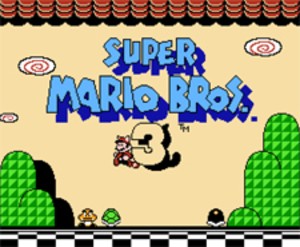
With hot competition from the newly released Sega Genesis / Mega Drive; Nintendo really showed what the NES was capable of with Super Mario Bros 3, which steadfastly ensured the continued sales success of the platform in the face of what was a technically superior rival.
The NES enjoyed a privileged place in gaming history. Nintendo introduced key franchises such as Mario, Zelda and Metroid brands to name but a few. The Virtual Console service has ensured that newcomers to the Nintendo universe never forget their roots. The early games are still playable and loved today, as proven by Super Mario Bros being the #1 most popular game for download on the VC.
Now, more than 20 years on after a turbulent few years during the N64 and Gamecube era, it appears Nintendo is back on track. The Wii encapsulates the original spirit of the NES as a "Family Computer." - Much like all those years ago when quirky peripherals such as R.O.B., the Zapper and the Power Glove captured a sceptical consumer's attention, now the Wii is winning over hearts and minds with its motion sensing technology. Games like Duck Hunt once got non-gamers gaming; now it is the turn of Wii Sports.


Comments 25
Good article! It's always interesting to see just how different the industry was back then, and the NES really was a gem of a console. I didn't own one sadly, but I've been able to discover many of its greats through remakes and the Virtual Console
there is no question that Super Mario 3 is in fact the best NES game ever, so you dont need to worry about that
very good article sir, sums up the NES and Nintendo's past fairly well, good work!
I like these articles, they brings a sense of (I can't remember the word, so I will say) warm deja-vu. The one thing that jumps into mind when I think about the NES is the advert proclaiming "The world's number one game system". and yes undeniably SMB3 - a work of genius.
The NES was awesome!
But the AVGN has something to say about the power glove:
http://www.youtube.com/watch?v=MYDuy7wM8Gk
I never owned a NES myself, mainly because of how young I am, but I played it at a friends place a few times with Duck Hunt, Super Mario Bros. and various other games and it was a blast.
it saddens me every time i think about the newer gamers, the ones younger than myself. the ones that started gaming with the PSX and N64.
Its nice to know that they will be given the chance to play NES and SNES games, as they were some of the best titles ever made. Perhaps not graphic-wise, but they still remain in the hearts of those that played them while growing up.
Me for example, Zelda, Super Mairo Bros. 3, Duck Hunt, TMNT 2: The Arcade Game, and then on the SNES, Secret of Mana, Illusion of Gaia(Time in PAL), Super Mario RPG, Donkey Kong Country, Zelda: LttP, Uniracers, and so on.
With those games, I fell in love with the nintendo systems. Nintendo hasn't been doing too well in the past couple years, but I think they finally hit the bullseye.
Stock in NTDOY has rocketed from 15$ 2-3 years ago, to 30$ last year, to 55$ today.
yeah I loved my NES. played till it disappeared in a move. stuiped movers. anyway, I loved the Soccer game on it, Mario and Duck Hunt, SMB3. those really were the best games to me at least. Zelda too.
Agreed, george. I got an NES in 1999, in mexico(i was 7), and got soccer, SMB 1 & 2, and Duck hunt for christmas. I did not Know of the SNES or N64, so I thought those games rocked, and they still do.
it's interesting to hear, how different the companys were present on the continents with their console's. i didn't know that sega was so popular in europe, especially in great britain! during my childhood nearly everybody got a nes and later on a snes! i only remember two persons who had a mega drive (genesis) and i never heard anything of a master system back then! hopefully i can play all my former favourite nintendo-games on the virtual console soon!
AH, they were the days! Like other kids my age I had to save up HARD for the NES console. I was lucky enough to have 2 brothers so while I got the NES my younger brothers clubbed together and got the master system. I left school at the end of the eighties and opened a business selling 8 bit games and games for the NES and Megadrive.
The NES is the reason I am on this page right now. It is the system that got me into gaming. I still have mine and its in perfect working order, still got the box and manual as well.
I was 4 back in late 1987 when my granddad decieded that it would be better if I got a modern games console. Before that I played my Mums cousins pong system. I liked it but it got boring after a while and tennis was no different to the other games. Despite the fact I was a girl my grandad went down to argos not to get me a new barbie(to be honest i actually played with transformers and thundercats more) but to get me a C64. They had no C64's in stock but they did have this new console by someone called Nintendo and sold by toy firm Mattel. Well my grandad knew all about Mattel so trusted the name and brought me the NES Super Mario Bros set. You got two pads(yes younger gamers you didn't used to have to buy another pad for two players) and Super Mario Bros for £99.99. Expensive in 1987 but still well worth it. I was hooked Mario was something I had never seen the likes of before it looked and sounded amazing. I could not do the first level at first but soon got the hang of it(i know its easy but I was 4). The NES was my primary console until 1992 when I got a SNES and it was and is still played often even now.
My first game that was not bundled with the console was Kung Fu which I picked after trying it out on the NES demo deck spoke about in the article. You got to choose from 15 games and got 5 mins on each(the shop chose how long you got with a timer they set in the system so the shop Darren went to was tight lol). The deck I used was at Toy & Hobby in Wigan an massive toy shop that sadly is long closed the firm going out of business years ago.(it next to Maximes night club for those that are from Wigan and cant remember it).
The third game I got was in 1988(NES games were £19.99 for black box titles to £40-£50 for some games, you could get some for £34 Zelda being one of them so they were expensive so I only ended up with 12 games in a 5 year spell, I have brought a lot more years later)and was Zelda 1. It was amazing a gold cartidge no game I had or rented had a gold cartidge, it came with a map and you could save with out a password. I still have the game box map and all in mint condition as i was a tidy kid so it was well looked after. Its still really good now if you ask me.
The Turtles deal with the NES was annoying for me a NES owner at the time. Why? Well for marketing reasons the game was at first only out to buy in a bundle, you could not buy the first Turtles game without buying a new NES at first which annoyed me no end. I got my Nan to write to Nintendo about it and they sent me a free Club Nintendo Membership and Duck Hunt and a Zapper to make it up to me(see Nintendo UK used to be good and Club Nintendo incase you are wondering was a fan club which was advertised via cards in NES GB games and you got 3 big newsletters a year with game pics in and posters stickerer etcs ). The game came two months later on its own but it was not worth the £34 from Woolworths my Nan and Mum paid for it.(yep in those days I not only got games from actual shops but also Woolworths a place I would not go near myself too dear but in those days it was there or the local import shops Cannings and Intergames or sometimes Toy & Hobby where I would get my games from).
The NES is a special console for me as it was my first and It was were I played Zelda, Mario and Metroid for the first time.
My friends did not have game consoles as they were girls and it was not the thing to have back then(didnt stop them playing my NES though). However two girls on my street the girl next door and next door to her had brothers that had a Spectrum and in the summer of 1991 a Megadrive. The lad up the road had an master system which was good also. I was the odd one out with the NES. I had the most powerful console on the street until that Megadrive turned up next door lol. I still remember seeing and playing Sonic 1 for the first time amazing it was. (didnt get Megadrive until Dec 1994 but played it and its games a lot prior to that)
So the NES rocked and still does now.
What about the power pad?
It was too awful to be mentioned!
http://en.wikipedia.org/wiki/Power_Pad
Never got to own a Nes myself, but one of my distant pals had one. I remember how he had to blow on the cartridges before playing a game, else there would be all kinds of strange graphical corruption.
Jade, you got a free Zapper?! Lucky girl. I got to play with a Zapper once and it was quite fun. I recall wondering how the Zapper worked back then; I thought it was something really sophisticated – now I know it’s just a light sensor with a button. Even so, I’m still amazed that it worked so well.
Cheers.
It was surpisingly accurate, sadly now I have an LCD tv I cant use the zapper properly anymore so im waiting for the VC to give me my gumshoe(the game on Wii play is basicly duck hunt and it works very well) fix. The blowing on carts thing did need to be done sometimes lol.
Did you ever notBald or anyone else use the Acclaim wireless pads. They looked really good but were about £40 for two so I never bothered as Id rather have a game than pads. Did they work?
I love the NES till this day.... the whole older era in fact.
I honestly play more VC titles than anything else on the wii.. Simple yet effective games... I would like them to release the 3 nes double dragons and of course the bad ass double dragons for SNES.
That old grey box brought alot of enjoyment, its a shame though young kids today don't "get" those older gems.
I honestly think NES/SNES vs competition should have been Turbo Grafx all along, Sega IMO was not even as fun as TG116 let alone SNES or NES.... Ok Sonic II was awesome but overall.
atari 2600,colecovision,nes,snes,n64,gamecube,wii. when my coleco died,the solution...NES!!! i almost forgot i had cosmic avenger and venture. NES!!!
I was given a NES for my eighth birthday, and when I look back on that day I die a little inside. I've never felt that feeling again, that indescribable feeling of owning something special. So many memories of the NES; Duck Hunt (the first true shooter), Mario, Zelda (with the golden cartridge). I remember blowing on the cartridge, I remember the pads making my hands hurt with the jagged edges, the luminous orange Zapper, everything. Aah, good ol' days. It saddens me that I'll never feel that feeling again, though the closest I came was getting an N64 for Christmas.
Every night, before going to sleep, I pray that Bad Dudes vs. Dragon Ninja is released on VC.
"I was given a NES for my eighth birthday, and when I look back on that day I die a little inside. I've never felt that feeling again, that indescribable feeling of owning something special. So many memories of the NES; Duck Hunt (the first true shooter), Mario, Zelda (with the golden cartridge). I remember blowing on the cartridge, I remember the pads making my hands hurt with the jagged edges, the luminous orange Zapper, everything."
Haha, almost the same as mine memory haha.
"though the closest I came was getting an N64 for Christmas."
NINTENDO SIXTY-FOURRRRRRRRRRRRRRRRRRRRRRR!!
lol
My dad came home one day with a suprise (he said). He had this black, thick plastic case, the sort of thing you see housing power tools. He opens the thing up and inside is this machine I had never heard of before. Two grey controllers and a game that he rented along with the package: Gradius. We played that thing all weekend before we had to return the system to the rental store. From that point on, I was totally hooked. To this day the NES is still my favourite system. The SNES is probably better overall, but its still a close second to the original. There was just something about the playability of these games...
My dad came home one day with a suprise (he said). He had this black, thick plastic case, the sort of thing you see housing power tools. He opens the thing up and inside is this machine I had never heard of before. Two grey controllers and a game that he rented along with the package: Gradius. We played that thing all weekend before we had to return the system to the rental store. From that point on, I was totally hooked. To this day the NES is still my favourite system. The SNES is probably better overall, but its still a close second to the original. There was just something about the playability of these games...
I will never forget playing Super Mario Bros. on my cousins NES when I went on holidays to New York when I was eleven. It was simply magical. That Christmas I got an NES bundled with the awful (but I thought it was brilliant at the time) TMNT. Pure joy. I don't think I have ever been as excited as when the ads for Super Mario Bros. 3 were shown on tv with all those kids all over the world shouting "Mario! Mario!" This system is why I am a 29 year old gamer!
The NES was my second real console (the 7800 doesn't count because it was basically the same as the 2600 and I didn't get a C64 until much later). It was like a box of pure joy. I was lucky enough to get a Track and Field bundle, which came with 2 controllers, a Zapper, the Power Pad, and a cart that had Mario, Duck Hunt, and World Class Track Meet on it. Dazza, I'm going to have to disagree with you on the Power Pad, that thing was a LOT of fun (if a bit useless, as I only ever played the track game with it). My friends and I spent many tiring nights running track events. It was a great party game accessory, though I'll admit that if I had actually spent money on it, I probably would've been a little irked by its limited usefulness.
Let me also put into perspective the Nintendo dominance in America at the time. Sega didn't exist. Atari was defunct. TurboGraphX-16 was a small blip on the radar. I had never even heard of the Master System until years after the Genesis was gone. If you gamed in the 8-bit era, you had an NES. Sega really exploded onto the scene with the Genesis, and I credit that to some clever marketing and Sonic. But Nintendo was by far the top dog, so much that a lot of people that I knew waited for the SNES instead of buying the Genesis.
I also want to stress the impact of the controller. It must seem weird to people who have grown up with D-pads and analog sticks, seeing as how simple the controller is, but anyone who has ever played an Atari 2600 knows what a huge step forward it was. The 2600 was great, and it had several different types of controllers that worked well to change the way you could play some games (the paddle wheel for Breakout, for instance), but not only were you stuck with a joystick (digital, mind you, not analog) and one button (can you even imagine?), but most of the ones I came across were stiff and vague; sometimes you'd really have to crank on the stick to get it to move, or push really hard on the button, and there was basically no positive feedback to really know for sure that you had gotten the input you were attempting. Gaming on the 2600 was, at times, a battle. Back then, we were having too much fun to really care, but gamers today wouldn't put up with any of those problems (and rightfully so). The Nintendo controller was sleek, compact, innovative, comfortable, and best of all, accurate. And it had four times as many buttons as Atari's system had. And we can't forget the D-pad, which made gaming SO much easier (with the 2600, you could either use the suction-cup joystick stuck to the table, or the joystick that you would hold with one hand and move with the other).
I could probably write endlessly about how great the NES was, and still is, but I won't. Nintendo's business practices, which certainly wouldn't fly today, deserve credit for allowing Nintendo to bring console gaming back from the brink.
The NES is home to some of the greatest games ever, one particular stand-out being Mike Tyson's Punch-Out!. I still play it more than almost any other game. Another favorite of mine is Super Mario 3. As great as Super Mario World is, Mario 3 is still my favorite Mario game and possibly my favorite game ever. If you want to know what the absolute pinnacle of 8-bit gaming was, then play Mario 3. The worst part about that game is that it leaps so far ahead of the original SMB (which is still a great game) that SMB pales in comparison to it.
There are a ton of other more obscure games out there, like Blaster Master, and Bump 'n' Jump, that most people probably wouldn't have played unless they were given it for Christmas like I was, so the people my age, who were too young to buy games during the NES days, tended to end up with a strange mix of random games given to them by grandmothers and such. But a lot of these games are good, too! There are some notable exceptions, like Lethal Weapon and Total Recall, which I clearly remember sucking (movie games, go figure), but back then, it did seem like that Nintendo Seal of Quality meant something.
NES is arguably the best console in history. i mean it uncrashed the video game crash so without it we may not have had Mario, Sonic, and other greats
I wonder if/when we get Rainbow Islands, whether America and Europe will get their unique original versions or if we will both get the American version. They are significantly different.
http://www.youtube.com/watch?v=2mjHijG3Nag
Tap here to load 25 comments
Leave A Comment
Hold on there, you need to login to post a comment...